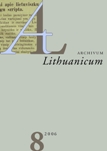Bendrinė kalba: tarmės pasirinkimas ir kodifikacija katalikiškojoje ir pasaulietinėje periodikoje (1889–1905)
The standard Lithuanian of secular and Catholic periodicals: The choice of the dialect and the need for codification (the end of the nineteenth century to the beginning of the twentieth century)
Author(s): Jurgita VenckienėSubject(s): Christian Theology and Religion, Theoretical Linguistics, Historical Linguistics, Baltic Languages, 19th Century, Pre-WW I & WW I (1900 -1919)
Published by: Lietuvių Kalbos Institutas
Keywords: Standard Lithuanian; Catholic; dialect; codification; 19th century; orthography;
Summary/Abstract: At the end of the nineteenth century the secular intellectuals and Catholic clergy were separately developing the bases of their written language models. In this article I analyze the development of the language of newspapers of these two groups: (1) the secular periodical Varpas (1889–1905); (2) the Catholic Žemaičių ir Lietuvos Apžvalga (1889–1896) and Tėvynės Sargas (1896–1904). I aim to identify the time when one of the models was recognized as more prestigious. Most attention is paid to the selection of the dialect and the rise of the need for codification. There were certain fluctuations of linguistic features in secular and Catholic periodicals even after the choice of the dialect for Standard Lithuanian. The secular standard was gaining strength at a faster pace, however. I treat the year 1893 as the turning point for the orientation of the Catholic clergy. This year they turned away from Kazimieras Jaunius’ grammar which had been used previously. (The priest Kazimieras Pakalniškis, the editor of Žemaičių ir Lietuvos Apžvalga, decided to stop changing the linguistic forms that were used by the authors.) For the clergy the language of the secular intellectuals seemed more grounded in the choice of dialect―Varpas was being issued by Southern West Highland Lithuanians who knew the dialect selected for the standard language better. Secular intellectuals and Catholic clergy were far more in competition with regard to the orthography. The “secular-style” writing of some forms was tolerated by the clergy from the year 1893 on. However, disagreement concerning graphic symbols lasted longer, since secular intellectuals had started the reform of the orthography with the goal of rejecting the traditional Polish way of writing. The change of traditional characters had been rejected in the Catholic environment since new characters were thought to be unfamiliar for the readers.
Journal: Archivum Lithuanicum
- Issue Year: 2006
- Issue No: 08
- Page Range: 9-42
- Page Count: 34
- Language: Lithuanian

